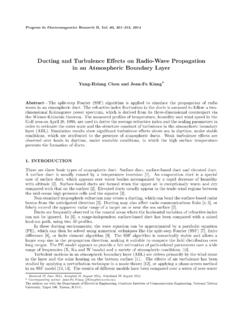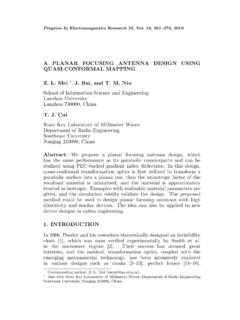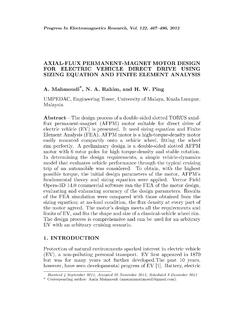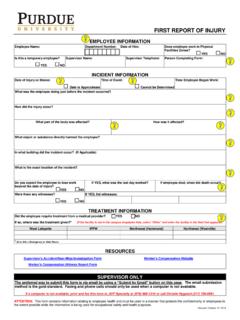Transcription of PLANAR INDUCTOR DESIGN FOR HIGH POWER …
1 Progress In Electromagnetics Research B, Vol. 35, 53 67, 2011. PLANAR INDUCTOR DESIGN FOR high POWER . applications . A. Eroglu*. Department of Engineering, ipfw , 2101 E. Coliseum Blvd., Fort Wayne, IN 46805, USA. Abstract DESIGN , simulation, and implementation of low profile microstrip spiral inductors for high POWER Industrial, Scientific and Medical (ISM) applications at the high frequency (HF-3 30 MHz). range are given for the first time. An accurate analytical model and algorithm have been developed to determine the simplified lumped element equivalent model parameters for spiral INDUCTOR and its physical dimensions. Five different spiral inductors are then simulated with a PLANAR electromagnetic simulator using the physical dimensions obtained for the desired inductance values with the analytical method.
2 The implementation method and substrate selection for spiral inductors at the HF range are given in detail for high POWER applications . The spiral inductors are then constructed on 100 mil Alumina substrate and measured with network analyzer. It is found that analytical, simulation and measurement results are in close agreement and the analytical method and algorithm that have been developed can be used to accurately determine the physical dimensions, and the resonant frequency of the spiral INDUCTOR for the desired inductance value. 1. INTRODUCTION. There is an increasing demand in the area of radio frequency applications to use cost effective PLANAR inductors . Spiral type PLANAR inductors are widely used in the DESIGN of POWER amplifiers, oscillators, microwave switches, combiners, and splitters, etc.
3 For ISM applications at the HF ( high frequency) range. There have been numerous publications on spiral INDUCTOR DESIGN at microwave frequencies. Significant portion of the related work on spiral inductors is dedicated Received 16 August 2011, Accepted 5 October 2011, Scheduled 8 October 2011. * Corresponding author: Abdullah Eroglu 54 Eroglu to DESIGN spiral inductors at microwave frequencies using substrates such as Silicon (Si) [1 5] or gallium-arsenide (GaAs) [6 8]. A modeling technique using time domain (TD) impulse to characterize microwave spiral inductors is proposed in [9]. LTCC spiral INDUCTOR DESIGN using the synthesis method is outlined in [10]. Chip spiral INDUCTOR DESIGN which is mostly valid for CMOS processes is given in [11]. In [12], DESIGN of the spiral inductors using layout synthesis and optimization technique on a crystalline polymer substrate is discussed.
4 Nano-spiral INDUCTOR DESIGN for low POWER digital spintronic circuits is presented in [13]. The inductance of the spiral INDUCTOR is calculated using Greenhouse-based formulation is given in [14 16]. Other methods such as empirical formulation in calculation of the inductance of the spirals are outlined in [17]. The inductance of the spiral using a mathematical model with Kramers Kronig relations are proposed in [18]. There have been also reports for calculating the spiral INDUCTOR parameters based on the measured S-parameters [19, 20]. Numerical methods such as finite difference time domain method (FDTD) and multi resolution time domain method (MRTD) [21, 22] have been also applied for characterization of the spiral inductors . However, none of the publications reported presents an analytical model for the DESIGN of spiral inductors at HF (3 MHz 30 MHz) range for high POWER ISM.
5 applications . HF range is a common frequency range that is used for ISM (Industrial, scientific, and medical) applications . Spiral inductors , when used in ISM applications , must be designed to handle POWER in the range of several kilowatts. They should demonstrate good thermal characteristics, sustained inductance value and low loss under such high POWER because any change in the component values in RF system affects the performance and can cause catastrophic failures. This can be prevented by application of an accurate DESIGN method for the material that is used as a substrate. In this paper, practical and accurate analytical DESIGN method and algorithm for low profile microstrip spiral inductors are proposed using the simplified lumped element equivalent model.
6 The method and algorithm are used to obtain the physical dimensions and resonant frequency of the spiral inductors for the desired inductance values. The physical dimensions are then used to simulate the spiral inductors by PLANAR electromagnetic simulator, Sonnet, to validate the DESIGN parameters. Spiral inductors are then implemented on 100 mil thick Alumina (Al2 O3 ) substrate using the implementation method proposed for the required level of POWER dissipation. Network analyzer, HP8753ES, is used to measure the inductance values and resonant frequencies of the spiral inductors . It has been seen that the results obtained by the developed analytical method and algorithm are in Progress In Electromagnetics Research B, Vol. 35, 2011 55. agreement with simulation and experimental results.
7 2. ANALYTICAL DESIGN METHOD FOR SPIRAL. INDUCTOR AT HF RANGE. DESIGN Equations The inductance value of the spiral inductors at the HF range can be determined using the quasi-static method proposed by Greenhouse [14]. with a good level of accuracy. The method in [14] takes into account of self coupling, and mutual coupling between each trace. The layout of the two conductors that is used in the inductance calculation is illustrated in Fig. 1(a). GMD. is the geometric mean distance between two conductors and GMD. represents the arithmetic mean distance between two conductors. The total inductance of the configuration of the spiral INDUCTOR is LT = L0 + M (1a). where LT is the total inductance, L0 is the sum of the self inductances, and M is the sum of the total mutual inductances.
8 The application of the formulation given by (1) can be demonstrated for the spiral INDUCTOR illustrated in Figs. 1(b) and 1(c) as LT = L1 + L2 + L3 + L4 + L5 2 (M13 + M24 + M35 ) + 2M15 (1b). The general relations that can be used in the algorithm for the spiral inductance calculation then become . li AMD . Li = ln 2 + + T (2). GMD li 4. Mij = Qi (3). 1 1 1 1. ln(GMD i ) = ln(d) 2 4 6 8 .. (4). 12 wd 60 wd 168 wd 360 wd . 2 ! 2! li li GMD i GMD i Qi = ln + 1+ 1+ + (5). GMD i GMD i li li AMD = w + t (6). where Li is the self inductance of the segment i, Mij is the mutual inductance between segments i and j, li is the length of segment li , is the permeability of the conductor, T is the frequency correction factor, d is the distance between conductor filaments, w is the width of the conductor, t is the thickness of the conductor, Qi is the mutual 56 Eroglu LT R( f ).
9 P1 P2. CT CT. (a) RP RP. (b) (c). Figure 1. (a) Rectangular Figure 2. Two-port lumped- spiral INDUCTOR . (b) Layout of element equivalent circuit for spi- current filaments. (c) Two- ral INDUCTOR . parallel filament geometry. inductance parameter of segment i, GMD i is the geometric distance of segment i, and GMD is the arithmetic mean distance. The two port lumped element equivalent circuit for a spiral INDUCTOR at the HF range is represented by a network shown in Fig. 2. CT is the lumped element equivalent circuit capacitance that has the effect of odd mode, even mode and interline coupling capacitances between coupled lines of the spiral INDUCTOR . The spiral INDUCTOR is separated into segments for overall capacitance calculation. The lines that are coupled and used for odd mode, even mode and interline coupling capacitances calculation are circled in Fig.
10 3. One half of the spiral INDUCTOR is used for the calculation of CT due to symmetry. The capacitance calculation for additional segments that are out of symmetric structure of the spiral INDUCTOR has to be performed and added to overall capacitance. The capacitance between spiral segments is found from the equivalent circuit shown in Fig. 4. Ce is the even mode capacitance, Co is the odd mode capacitance and Cc is the interline coupling capacitance in Fig. 4. The calculation of the even and mode capacitances are given in detail in [23, 24]. The interline coupling capacitance is found from 1. Cc = (Co Ce ) [F/m] (7). 2. After calculation of the coupling capacitances between the coupled Progress In Electromagnetics Research B, Vol. 35, 2011 57. l1.






